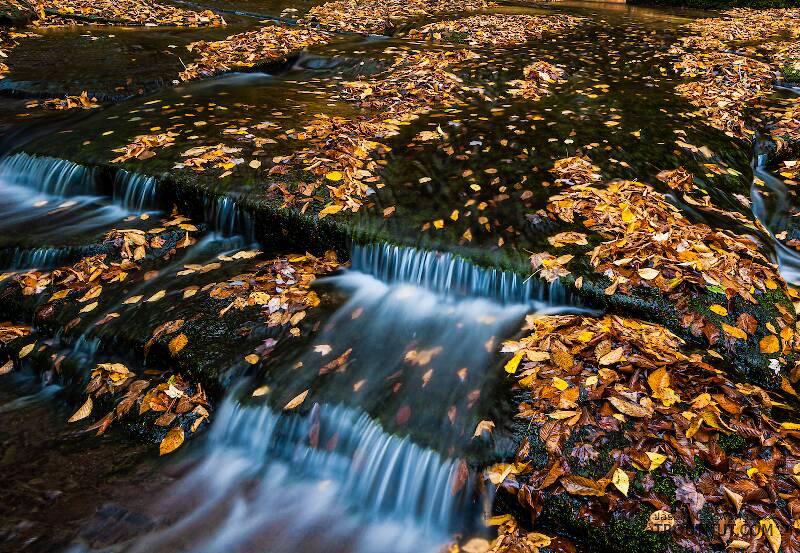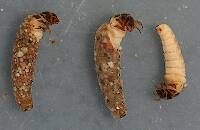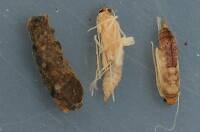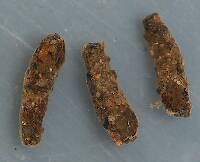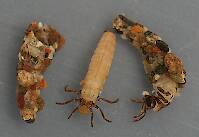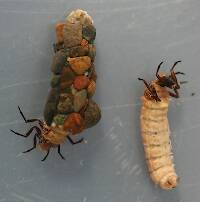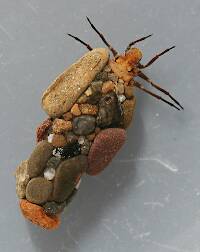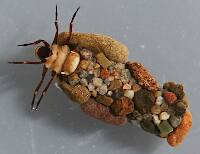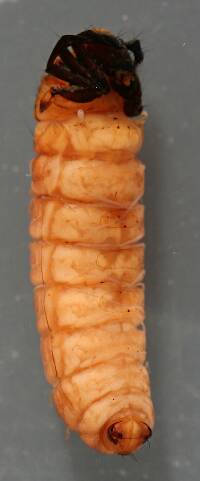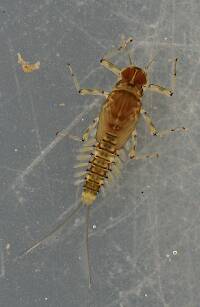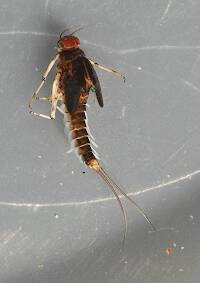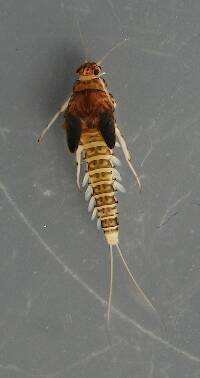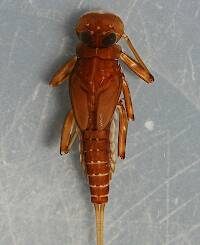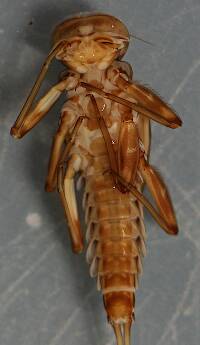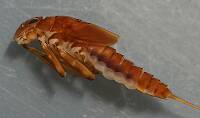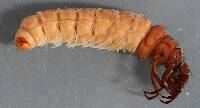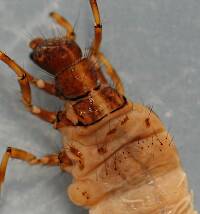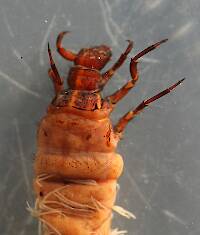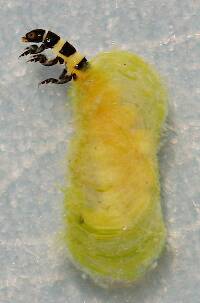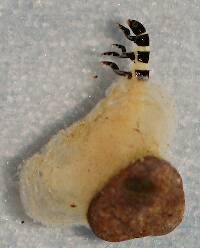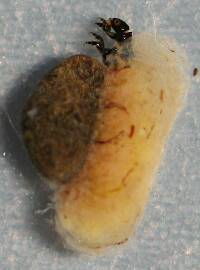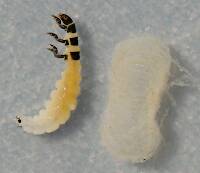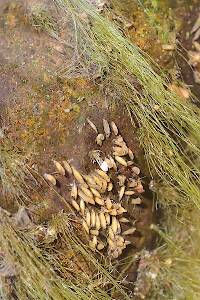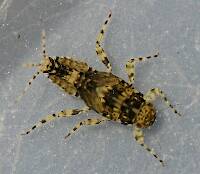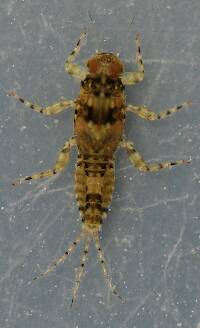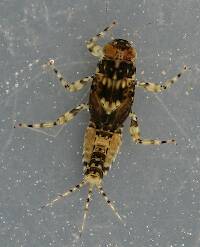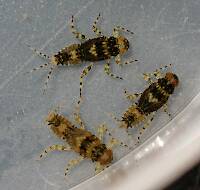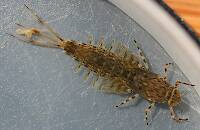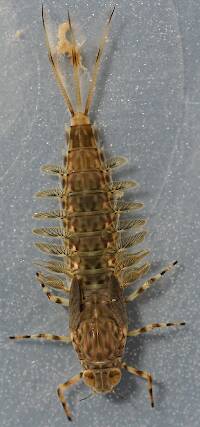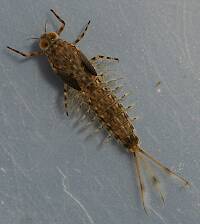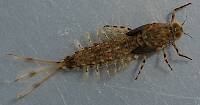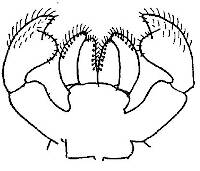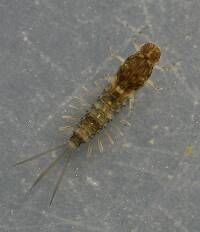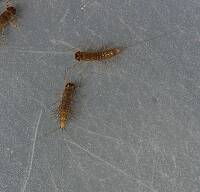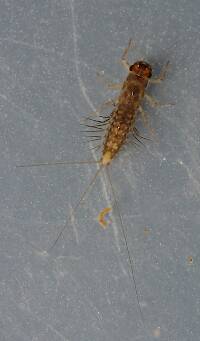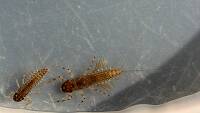
Hex Mayflies
Hexagenia limbata
The famous nocturnal Hex hatch of the Midwest (and a few other lucky locations) stirs to the surface mythically large brown trout that only touch streamers for the rest of the year.
Featured on the forum

It's only barely visible in one of my pictures, but I confirmed under the microscope that this one has a prosternal horn and the antennae are mid-way between the eyes and front of the head capsule.
I'm calling this one Pycnopsyche, but it's a bit perplexing. It seems to key definitively to at least Couplet 8 of the Key to Genera of Limnephilidae Larvae. That narrows it down to three genera, and the case seems wrong for the other two. The case looks right for Pycnopsyche, and it fits one of the key characteristics: "Abdominal sternum II without chloride epithelium and abdominal segment IX with only single seta on each side of dorsal sclerite." However, the characteristic "metanotal sa1 sclerites not fused, although often contiguous" does not seem to fit well. Those sclerites sure look fused to me, although I can make out a thin groove in the touching halves in the anterior half under the microscope. Perhaps this is a regional variation.
The only species of Pycnopsyche documented in Washington state is Pycnopsyche guttifera, and the colors and markings around the head of this specimen seem to match very well a specimen of that species from Massachusetts on Bugguide. So I am placing it in that species for now.
Whatever species this is, I photographed another specimen of seemingly the same species from the same spot a couple months later.
I'm calling this one Pycnopsyche, but it's a bit perplexing. It seems to key definitively to at least Couplet 8 of the Key to Genera of Limnephilidae Larvae. That narrows it down to three genera, and the case seems wrong for the other two. The case looks right for Pycnopsyche, and it fits one of the key characteristics: "Abdominal sternum II without chloride epithelium and abdominal segment IX with only single seta on each side of dorsal sclerite." However, the characteristic "metanotal sa1 sclerites not fused, although often contiguous" does not seem to fit well. Those sclerites sure look fused to me, although I can make out a thin groove in the touching halves in the anterior half under the microscope. Perhaps this is a regional variation.
The only species of Pycnopsyche documented in Washington state is Pycnopsyche guttifera, and the colors and markings around the head of this specimen seem to match very well a specimen of that species from Massachusetts on Bugguide. So I am placing it in that species for now.
Whatever species this is, I photographed another specimen of seemingly the same species from the same spot a couple months later.

Troutnut is a project started in 2003 by salmonid ecologist Jason "Troutnut" Neuswanger to help anglers and
fly tyers unabashedly embrace the entomological side of the sport. Learn more about Troutnut or
support the project for an enhanced experience here.
















Millcreek on Oct 25, 2014October 25th, 2014, 1:27 pm EDT
Admittedly it's a bit dubious whether these are of much importance for trout fishing but they are indicators of good water quality. Marilia pupae and adults can be numerous enough locally to create a good emergence.
Marilia is represented by one species in California, Marilia flexuosa. In this area of the Russian River its commonly collected in samples. The larvae spend most if not all of their time burrowed into the substrate. They are most commonly collected in riffles and glides with a fast flow of water and an unembedded substrate of gravel and cobble with deposits of fine to coarse sand and fine gravel. Larvae are almost never collected on top of the substrate but can be found in large numbers by digging in sand and gravel with your fingers. Pupae can be found on the sides and occasionally on the bottom of large pieces of gravel or cobble. They seem to prefer cracks or crevices on the rocks to attach their cases and are often found in aggregations. The larvae attach the case to the rock at the front and back, then use a small stone to plug each end of the case. Some larvae attach several stones to the posterior end of the case when preparing the pupal chamber. When pupae are ready to emerge they cut loose the rock at the front of the case. Marilia seem to prefer the mainstem of the river and I haven't found any in smaller tributaries.
Nerophilus is a monotypic genus represented only by Nerophilus californicus. Nerophilus larvae in this area are found in the smaller tributaries of the Russian River. They are usually collected in well canopied areas with a substrate of large cobbles and boulders with deposits of sand on the downstream side of them and a fast flow of water. All I have collected were found under the sand. I haven't found any pupae and collections of adults have been few and far between.
Marilia is represented by one species in California, Marilia flexuosa. In this area of the Russian River its commonly collected in samples. The larvae spend most if not all of their time burrowed into the substrate. They are most commonly collected in riffles and glides with a fast flow of water and an unembedded substrate of gravel and cobble with deposits of fine to coarse sand and fine gravel. Larvae are almost never collected on top of the substrate but can be found in large numbers by digging in sand and gravel with your fingers. Pupae can be found on the sides and occasionally on the bottom of large pieces of gravel or cobble. They seem to prefer cracks or crevices on the rocks to attach their cases and are often found in aggregations. The larvae attach the case to the rock at the front and back, then use a small stone to plug each end of the case. Some larvae attach several stones to the posterior end of the case when preparing the pupal chamber. When pupae are ready to emerge they cut loose the rock at the front of the case. Marilia seem to prefer the mainstem of the river and I haven't found any in smaller tributaries.
Nerophilus is a monotypic genus represented only by Nerophilus californicus. Nerophilus larvae in this area are found in the smaller tributaries of the Russian River. They are usually collected in well canopied areas with a substrate of large cobbles and boulders with deposits of sand on the downstream side of them and a fast flow of water. All I have collected were found under the sand. I haven't found any pupae and collections of adults have been few and far between.
"If we knew what it was we were doing, it would not be called research, would it?"
-Albert Einstein
-Albert Einstein
Oldredbarn on Oct 26, 2014October 26th, 2014, 6:46 pm EDT
Wow! What great pics Mark...What little craftsmen they are.It is really cool to see how the antenna and legs are "stowed" in that tight space.
Thanks again!
Spence
Thanks again!
Spence
"Even when my best efforts fail it's a satisfying challenge, and that, after all, is the essence of fly fishing." -Chauncy Lively
"Envy not the man who lives beside the river, but the man the river flows through." Joseph T Heywood
"Envy not the man who lives beside the river, but the man the river flows through." Joseph T Heywood
Millcreek on Oct 27, 2014October 27th, 2014, 7:35 am EDT
Spence,
Yeah, these guys are really master masons. Nothing extra in the cases, but what's used is used to maximum effect. An excellent example of less is more.
Mark
What little craftsmen they are.
Yeah, these guys are really master masons. Nothing extra in the cases, but what's used is used to maximum effect. An excellent example of less is more.
Mark
"If we knew what it was we were doing, it would not be called research, would it?"
-Albert Einstein
-Albert Einstein
Crepuscular on Oct 29, 2014October 29th, 2014, 5:58 am EDT
Cool photos Mark. I get some pretty neat Odontocerids here from spring seeps that make their cases out of pieces of quartz. I think there is a post on here somewhere. Psilotreta rufa I found it...
http://www.troutnut.com/topic/7815/Another-Caddisfly#35252
http://www.troutnut.com/topic/7815/Another-Caddisfly#35252
Millcreek on Oct 29, 2014October 29th, 2014, 9:02 am EDT
Eric - Took a look at your link to the Psilotreta rufa photos. Interesting little critter. Also interesting that you found them out in the open. I haven't found Marilia larvae outside the substrate except for an occasional straggler. The pupae are out in the open on large gravel and cobble. Nerophilus larvae I've collected have always been under the substrate. I suppose they might come out at night but don't really know for sure.
On your post on Psilotreta rufa it seemed the larvae were variable in coloration. This is true of the Marilia larvae as well. They can vary from a cream to light green body color. Seems to be true of all the larval instars. Nerophilus larvae don't seem to vary much in color.
You might be interested in this site http://aquaticinsectsofcentralvirginia.blogspot.com/2011/09/found-odontoceridae-strong-case-maker.html if you haven't already run across it.
On your post on Psilotreta rufa it seemed the larvae were variable in coloration. This is true of the Marilia larvae as well. They can vary from a cream to light green body color. Seems to be true of all the larval instars. Nerophilus larvae don't seem to vary much in color.
You might be interested in this site http://aquaticinsectsofcentralvirginia.blogspot.com/2011/09/found-odontoceridae-strong-case-maker.html if you haven't already run across it.
"If we knew what it was we were doing, it would not be called research, would it?"
-Albert Einstein
-Albert Einstein
Quick Reply
Related Discussions
Topic
Replies
Last Reply

